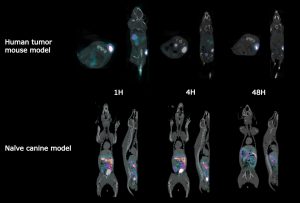Increase the success rate of drug candidates by preclinical investigation including both small and large animal models
Comprehensive investigation of drug candidates in the preclinical setting have shown beneficial for the latter clinical evaluation of new drug candidates. Since the perfect animal model does not exist, combining several SPECT/CT images from multiple species in the preclinical setting may not only give you more valuable data, but it can also be a necessity.
At Minerva Imaging, we have extensive experience in design and execution of preclinical studies for drug development. We engage with our clients to understand their scientific questions and discuss how our methods and capabilities can provide answers. We offer the opportunity to investigate your compound of interest in relevant small and large animal models. Our facilities furthermore include several imaging modalities for both small and large animals. This allows for a comprehensive preclinical investigation of lead candidates to support clinical translation.
For animal models and targeted therapies, the concern of cross reactivity across species is an impediment throughout preclinical investigations. A preclinical setup with both small and large animals gives a better indication of your compound’s biodistribution and efficacy. One of the recent studies performed at Minerva Imaging shows the benefits of such a setup in the field of targeted radionuclide therapy.
Compound distribution to tumor using small animal SPECT/CT and treatment efficacy was tested in human tumor mouse models. Results show high target mediated uptake in tumors and low off-target uptake, Figure 1 top panel. However, due to lack of cross reactivity between the compound and its target in mice, the biodistribution could be misleading. The compound demonstrated cross reactivity to the target in canine species and a biodistribution study was performed in canine. Figure 1 bottom panel, shows the biodistribution of the investigated compound evaluated by quantitative SPECT/CT imaging in a naïve canine model.

Figure 1: Compound distribution to tumor using small animal SPECT/CT in human tumor mouse model (top) and naïve canine model (bottom).
The combination of results obtained from biodistribution and efficacy studies in human tumor mouse models and the biodistribution study performed in a large animal model with confirmed cross reactivity comprise a comprehensive and valuable IND-enabling data package to support clinical translation.
At Minerva Imaging we are happy to share this data about combining SPECT/CT images, showing our in vivo capabilities. Interested in how a collaboration would work for you? Contact us for more information.
 Back to news
Back to news